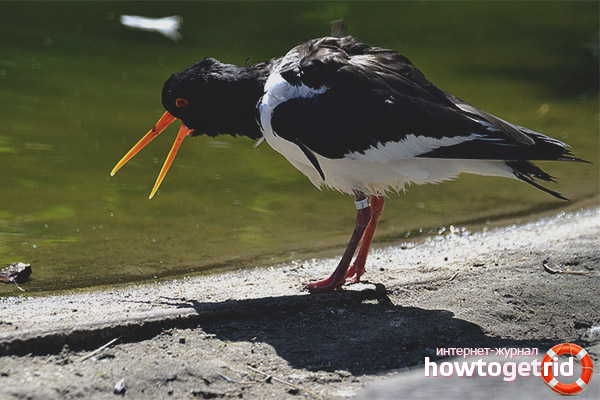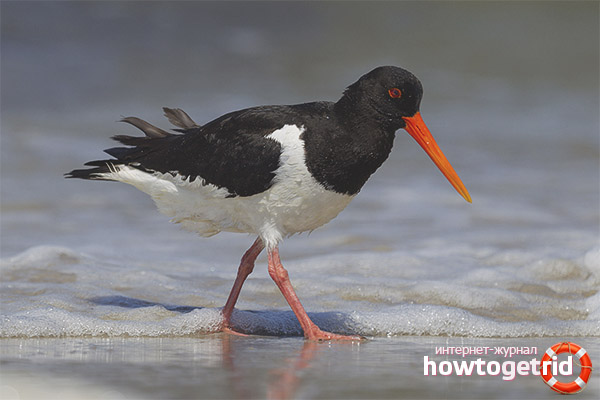The content of the article
A small bird, a bright representative (thanks to a peculiar red-orange beak) of the Haematopodidae family, the national representative of the Faroe Islands - it's all a magpie. It also belongs to the charadriiformes. This bird, due to its characteristic appearance, is quite easily recognizable, and in size it is similar to a crow.
An adult magpie sandpiper weighs about 420-820 gr., The body length of the bird is 40 to 50 cm, the wingspan is 85-87 cm. The black-and-white contrast plumage is typical for the individual. Thanks to the quail plumage, which is similar to the plumage of a magpie, the bird received such a Russian nickname. Some subspecies: Far Eastern and mainland, are listed in the Red Book of Russia (the 3rd category is a subspecies that has become rare as a result of human activity).
The front region of the back, neck, middle and small covering wings, the top of the chest and the ends of the wings are painted black with a characteristic metallic sheen, during the mating season, in an adult magpie. A stripe of white color passes over the wings. The abdomen, flanks, lower part of the wings and other parts of the body that are not mentioned above are also painted white. In addition, a small white spot magpie is “marked” in the area below the eye.
A characteristic feature of the magpie sandpiper is a bright red-orange beak, 8-10 cm in length. The same color is observed in the iris. Legs short enough for this size of the bird are painted red-pink.
With the advent of autumn, no trace remains of the metallic glow of plumage. But there is a spot in the throat, white, in shape resembling a half-neck. Moreover, during this period, the end of the beak changes color - it becomes darker. Due to poorly developed sexual deformism, it is not possible to distinguish the female from the male in appearance.
Unlike adults, young growth is characterized by the presence of a brownish tint of the dark part of the plumage. Also, the latter lack a white spot on the throat. The distinctive features of young animals include: light gray foot color and beak color - in young individuals only its base is colored in orange, the rest is dark gray in color.
Magpie Sandpiper Habitat
Sandpiper-forty three populations into which this species is divided, lives on the territory of Eurasia. However, each population exists in isolation from each other and is allocated in a separate subspecies. The characteristic differences of each subspecies are the size of the birds, the length of their beak and the color of the details of the plumage. Let us dwell in more detail on each of the subspecies.
Northern Sandpiper Magpie. This subspecies is considered to be nominative. It nests along the shores of the seas of Europe and Iceland. This subspecies is widespread in the northern Mediterranean, as well as in the northern regions of the Atlantic. The greatest number of individuals of the northern magpie-magpie is concentrated in the range of the North Sea. From here, the population moves inland and settles in the river valleys. This subspecies is often found on the territory of the Arctic coast of the Russian Federation, as well as in the east, near the mouth of the Pechora River. Inland waters of the Netherlands, Sweden, Ireland, Scotland and Turkey are the favorite habitat of the northern magpie
Mainland magpie magpie. The range of this subspecies is represented by the mainland of Asia Minor, eastern Europe in the west and Western Siberia, up to the lower reaches of the Ob and Abakan rivers in the east. The range of the western part of the Russian Federation is sporadic (irregular) in nature.Most often, the mainland sandpiper-magpie is found in the valleys and tributaries of the Northern Dvina, Don, Volga, Desna, Pechora, Irtysh, Ob.
Far Eastern sandpiper-magpie. This subspecies is considered to be the most eastern. Nesting sites of this subspecies are found in Kamchatka, in Primorye, in the west of the Korean Peninsula and in northeastern China.
How does a magpie live?
The biotope of this bird should be understood as island terrain, coasts of the seas, river valleys (preferably gentle) and the shores of lakes. The sandpiper is often found near the mouths of small rivers and along their coastline.
The rhythm of ebbs and flows is directly related to the life cycle of these birds. And all because the water that receded at low tide exposes the bottom, which is replete with food.
What does the magpie eat?

The basis of the diet of this species of birds are a variety of invertebrates. Sandpiper feeds on polychaete worms, mollusks, insects, and crustaceans. Occasionally, small fish are found in the diet. Those subspecies that live on the sea coast feed mainly on bivalve mussels: mussels, heart-shaped, Baltic mackerel, etc. On the river coasts and inland waters, the basis of the diet is earthworms, larvae and insects.
Due to the aggressive nature, magpie waders often clash with each other for more attractive food areas. They use a long beak to tear sand in search of food.
How do magpie waders breed?
Birds fly to the nesting area in mid-April. Moreover, there are frequent cases of arrival at the same nesting sites that the pairs occupied a year earlier.
In the laying of the magpie, there are 3 eggs, although there are nests with 2 or 4 eggs. During the entire incubation period (26-27 days), both male and female hatch eggs. The nest should be under round-the-clock "protection", because its contents are not averse to feasting on crows and gulls. As soon as the chicks are born, they are already able to leave the nest, but parents control and feed them for 6 weeks.
Video: magpie (Haematopus ostralegus)











Submit